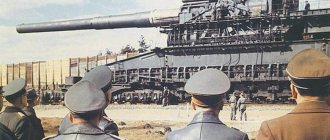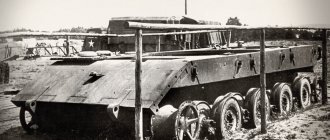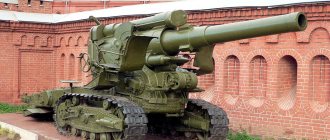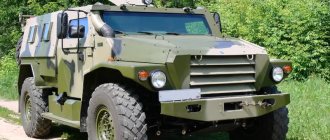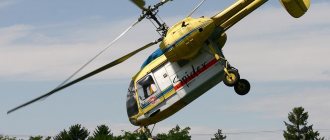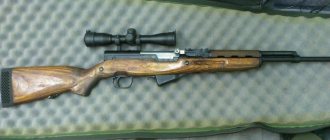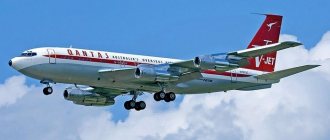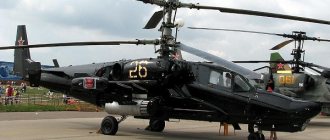Losers of "Movag"
The Swiss company, now part of the General Dynamics concern, is known primarily as the developer and manufacturer of the commercially successful Piranha family of armored personnel carriers. But the company's history also had failures. In general, the good armored vehicles “Puma” and “Shark” could not find their niche in the arms market.
The Swiss military museum in Full has a solid collection of armored vehicles, clearly showing the evolution of products. Among the prototypes of production vehicles, there are also samples that did not make it onto the factory assembly line. The history of their creation, as well as some engineering solutions, are of interest to fans of military equipment.
Three-axle "Puma"
In the early 60s, it created two successful models of two-axle armored personnel carriers - the Wotan (MR-8), adopted by the German border guard, and the lighter Roland, exported to Greece and a number of Latin American countries. Based on this successful experience, Movag’s management decided to try their luck in a heavier class by developing a 15-ton armored personnel carrier. The new vehicle had to meet the highest requirements of the time, in particular, be amphibious and able to operate in conditions of the use of weapons of mass destruction.
The car, called "Puma", was ready in 1966. The three-axle all-wheel drive vehicle had the first and third steered axles. The power plant of Movag's own design included an eight-cylinder V-shaped diesel engine M8DV with a power of 320 hp. and a manual transmission M130-16S (six forward speeds and two reverse). Movement afloat was provided by two propellers.
The prototype of the "Puma" (with a turret from the HS30 armored personnel carrier) in the museum exhibition Visinger L. Kolová vozidla MOWAG. ATM, 2022, No. 2
The Puma was designed to carry 11 people - a commander, driver, gunner and eight paratroopers. The latter dismounted through the doors in the rear wall of the hull. There were two embrasures in the doors for firing from automatic rifles, but there were no embrasures in the sides of the vehicle.
The basic weapon option for the Puma was considered to be a single-seat Hispano-Suiza turret (similar to the one on the HS30 tracked armored personnel carriers) with a 20-mm HS820 cannon and a 7.62-mm MG3 machine gun, as well as six 76-mm smoke grenade launchers. It is in this configuration that the prototype armored personnel carrier is presented in the museum. But other weapon options were also tested on the Puma, for example, two MG3 machine guns on remote-controlled carriages (similar to the one developed for the Marder infantry fighting vehicle). We also tested a twin launcher of 81-mm unguided missiles MRS-80 with a reloading mechanism - this sample is so interesting that it deserves a separate story. The projects included various options for arming the Puma with 30-mm and 40-mm cannons, including anti-aircraft ones.
Option to arm the Puma with two 7.62 mm machine guns on remote-controlled carriages pinterest.com
“Puma” was successfully demonstrated at training grounds, military personnel from various countries inspected the armored personnel carrier, clicking their tongues in admiration, but that was all over. The complex and expensive machine was ahead of its time. learned her lesson and began developing a cheaper alternative - the famous Piranha.
Heavy weapon carrier
The Piranha, launched into production in 1972, has demonstrated significant development potential - suffice it to say that the fifth generation of this armored personnel carrier is currently in production. However, the layout of the Piranha with a front-mounted power plant imposed certain restrictions on the placement of heavy weapons systems - for example, air defense systems or turrets with tank guns. Therefore, in 1978, the development of the Shark four-axle armored vehicle began. It used some of the design solutions of the Piranha, but was created as a weapon carrier (Waffenträger). The main difference between the Shark was the rear location of the engine, which made it possible to install a turret with weapons in the center of gravity of the vehicle.
Chassis "Shark" in the museum exhibition Visinger L. Kolová vozidla MOWAG. ATM, 2022, No. 2
The Shark prototype, whose construction was completed in March 1981, was equipped with an eight-cylinder 8V71TA engine that developed 530 hp. Access to it was provided through two large hatches in the roof of the hull. The engine block was equipped with an Allison NT-750 automatic five-speed gearbox. The steered first and fourth axles had spring suspension, while the second and third had torsion bar suspension. Michelin pneumatics made it possible to move even with several bullet holes. Despite its “shark” name, “Shark” was not a swimmer.
The body of the armored vehicle was made of steel armor and provided protection against 14.5 mm bullets. At the request of the customer, the Shark could be equipped with night vision devices, an automatic fire extinguishing system and a filter-ventilation unit.
Without weapons, the Shark weighed 16 tons, and the permissible weight of the installed weapon system was 6 tons. During the first presentation in Paris, the vehicle carried an Oerlikon GDD-BOE turret with a 35-mm KDE cannon (ammunition - 151 rounds), 7.62 -mm machine gun (230 rounds) and six 76mm smoke grenade launchers. In this configuration, the Shark could be used as a reconnaissance armored vehicle, but it was still too large for this. Actually, this was a purely demonstration option - Movag focused on advertising the Shark as a “wheeled tank” (a tank destroyer armed with a relatively large-caliber gun), as well as a carrier of air defense systems. Options for using the Sharka chassis to accommodate an anti-tank missile system and even an MLRS were also considered, but they were not a priority.
"Wheeled Tank"
In the spring of 1982, tests began on the Shark with the French-made Five-Cyle-Babcock FL-12 turret. It was a further development of the oscillating turret concept implemented in the FL-10 on the AMX-13 tank. The FL-12 itself was by no means new - since 1971 it was installed on the Austrian SK-105 Cuirassier light tanks. The turret was equipped with a 105-mm rifled cannon GIAT CN-105/57 and a coaxial machine gun. The gun's ready-to-fire ammunition consisted of 12 shells placed in two revolving magazines in the rear of the upper (swinging) part of the turret.
"Shark" with turret FL-12 Visinger L. Kolová vozidla MOWAG. ATM, 2022, No. 2
After a series of tests, the FL-12 turret was dismantled, and the Shark prototype was lent to the Rheinmetall concern. A large three-man turret with a low-impulse 105-mm Rh 105-11 rifled gun, also called Rh 105SLR (Super Low Recoil) was installed on the chassis of the armored car. Unlike the CN-105/57, the Rheinmetall gun could fire not only cumulative shells, but also sub-caliber armor-piercing shells, the initial speed of which was 1470 m/s. The gun was complemented by two 7.62 mm machine guns - coaxial and anti-aircraft.
1/2
Heading1
Heading2
"Shark" with a three-man Rheinmetall turret pinterest.com
"Shark" with LATS tower pinterest.com
After practicing with the manned turret, Rheinmetall specialists installed a LATS (Light Armored Turret System) turret with a remote installation of a 105-mm cannon and an automatic loader on the Shark. But that was not all. The fourth “tank” turret tested on the Shark was the FL-20. It mounted a 105-mm CN-105F1 gun, equipped with a muzzle brake and capable of firing sub-caliber projectiles. Auxiliary weapons were represented by a 20-mm automatic cannon. Alas, none of the four configurations of the “wheeled tank” on the Sharka chassis aroused interest among potential customers.
Anti-aircraft self-propelled gun
In 1983, she produced two more prototypes of the Shark armored vehicle, which made it possible to expand the scope of experimental work. At the end of the year, one of the chassis was used to manufacture the second prototype of the Wildcat self-propelled gun (the first was built in 1981 on the chassis of the West German TPz-1 Fuchs armored personnel carrier). The system, developed by a consortium of West German companies, Siemens, Mauser, KUKA, AEG) together with Hollandse Signal Apparaten, was conceptually similar to the Gepard self-propelled gun, but had a lighter turret suitable for installation on a wheeled chassis. On the sides of the turret, two 30-mm Mauser MK 30F automatic cannons with 250 rounds of ammunition per barrel were mounted on swinging carriages. Depending on the wishes of the customer, the fire controls could be configured in six options - from the simplest V1 to the most sophisticated all-weather V6. Both prototypes (on the Fuchs and Sharka chassis) were an intermediate V3 configuration that provided automatic target tracking based on radar data. However, Wildcat did not live up to the hopes of its developers. For Third World countries, this ZSU turned out to be too expensive, and European armies rejected it due to its short firing range - the anti-aircraft gun could not hit combat helicopters before they reached the ATGM launch line.
1/2
Heading1
Heading2
ZSU "Wildcat" on the chassis "Shark" war-book.ru
"Shark" with Trinity turret Visinger L. Kolová vozidla MOWAG. ATM, 2022, No. 2
In addition to the Wildcat, two more types of turrets for self-propelled guns were tested on the Shark chassis. One of them is the Swedish Trinity with a 40-mm cannon and a developed fire control system, which included a radar, an infrared camera and a laser rangefinder. The second is made in Italy with four 25-mm Oerlikon KVA cannons and an electro-optical daytime fire control system.
Option for placing the Krotal air defense system on the Shark chassis Visinger L. Kolová vozidla MOWAG. ATM, 2022, No. 2
A very promising area of application for the Shark was its use as a chassis for short-range air defense systems. In particular, the French tested its Crotal complex with four launch containers for the R.440 missile defense system at its base. The second missile system installed on the Shark was the ADATS multi-purpose (anti-aircraft/anti-tank) complex. The system, considered very promising in the 80s, was developed jointly by the Swiss Oerlikon and the American concern Martin Marietta. Indeed, ADATS had some commercial success - the complex was sold to Canada and Thailand, but none of these countries chose the Shark chassis.
ADATS missile system on the Shark chassis war-book.ru
Neither Puma nor Shark became commercially successful Movag projects.
After riding on training grounds, showing off at exhibitions and on the pages of advertising brochures, they disappeared into oblivion, remaining only in museum displays. But the experience of their creation was not wasted - it was taken into account by Movag specialists when creating and improving the machines of the Piranha family. Tactical and technical characteristics of armored vehicles "Puma" and "Shark"
| "Puma" | "Shark" | |
| Crew (landing force), people. | 3(8) | 3-4 |
| Maximum weight, t | 15 | 22 |
| Length, m | 6,75 | 7,52 |
| Width, m | 2,6 | 3 |
| Body height, m | 2,08 | 1,9 |
| Ground clearance, m | 0,35 | 0,46 |
| Engine power, hp | 320 | 530 |
| Highway speed, km/h | 80 | 100 |
| Speed afloat, km/h | 12 | — |
| Cruising range, km | 400 | 500 |
Literature:
- Bauer M. Nutzfahrzeuge der MOWAG Motorwagenfabrik AG. Fachpresse Goldach, Hudson & Company, 1996
- Visinger L. Kolová vozidla MOWAG. ATM, 2022, No. 2
- tanks-encyclopedia.com
Sd.Kfz.234
Sd.Kfz.234
The order to create a new armored car, designed to replace vehicles based on the GS chassis, came from the Ministry of Armaments on August 5, 1940.
The tactical and technical requirements provided for the vehicle’s ability to operate in the extreme conditions of the Sahara: it was for the North African theater that the new armored car was primarily created. To increase the power reserve, it was planned to equip the car with an air-cooled diesel engine with a power of more than 200 hp. Particular attention was planned to be paid to the ventilation of the fighting compartment. The creation of a new armored car was entrusted to Bussing-NAG. The turret for the armored car was created by two companies at once: Daimler-Benz AG and Friedrich Schichau. The Czech company Tatra received an order to design a 12-cylinder diesel engine with a volume of 14,800 cm? and power 210 hp. at 2200 rpm. The engine weight should not exceed 700 kg.
Heavy armored car Sd.Kfz.234/1
The first two prototypes were presented to the Ministry of Armaments at the end of 1941. At Bussing-NAG, the prototype was given the factory designation ARK (Achtradkraftwagen - eight-wheeled vehicle). After short tests, army representatives demanded modifications to the Tatra 103 diesel engine. The military’s comments concerned, first of all, the cooling and power supply systems of the engine. In addition, according to the military, the diesel engine made too much noise when operating, which quickly tired the crew. To reduce noise levels, it was necessary to radically redesign the exhaust system.
Comprehensive testing began on June 8, 1942, and in July the vehicle was declared complete. However, the question of producing an armored car has not yet been raised, since throughout the second half of 1942 Tatra was fine-tuning its diesel engine, trying to adapt it for use in desert conditions. However, circumstances were such that this work could not be completed. But the ARK vehicles themselves, created primarily for the German Afrika Korps, never made it to North Africa. The remnants of the German army in Tunisia capitulated in May 1943, even before the start of serial production of the new armored car.
Comparative sizes of German heavy armored vehicles
The development of ARK took a long time. At this time, tanks and self-propelled guns were given priority, and there was neither time nor funds left for work on armored vehicles. As a result, until 1943, the Germans continued to produce obsolete Sd.Kfz.231 (8-Rad), since there was nothing to replace them.
Only in the spring the situation changed. In March, Panzerwaffe Inspector General Heinz Guderian handed Hitler a report, which said, among other things: “If, I hope, we are again able to conduct large-scale operations in 1944, we will need to establish effective reconnaissance. For this purpose, we need a reconnaissance armored vehicle with high speed (60 - 70 km/h), with thick armor and good weapons. We currently do not produce such equipment. I ask you to discuss this problem with Minister Speer and solve it somehow.”
Soon preparations began for mass production of the new armored car. Final assembly was carried out at the Bussing-NAG plant in Leipzig. The hulls were supplied by Deusche Edelstahlwerke, which manufactured the first three hulls in May 1943. The new armored car received a long name - schwerer Panzerspahwagen Sd.Kfz.234 mit ARK Fahrgestell. Initially it was planned to produce 30 cars monthly. But very soon the plans were revised upward - to 80 units. The overall production plan also increased significantly: from 500 to 1,500 Sd.Kfz.234 armored vehicles.
The new eight-wheeled armored vehicles were similar in design, layout and appearance to the Sd.Kfz.231 (8-Rad), but had one fundamental difference - a load-bearing welded body. Unlike its predecessor, the Sd.Kfz.234 had a frontal armor thickness of 30 mm from the very beginning, which protected the vehicle not only from anti-tank rifles and heavy machine guns, but even from 20 mm cannons. But the sides and rear were still made of 10 mm armor plates.
Engine Tatra 103
Forward control station. Noteworthy is the reverse tilt of the steering wheel.
In the front part of the vehicle body there was a control compartment, in which the driver’s workplace was located in the center. To the right of his seat, batteries were stored in a metal cabinet, and to the left was a large lockable box for tools and spare parts. Between the battery cabinet and the driver's seat there was a gear shift lever and a range lever. The instrument panel with the main control devices and sensors was to the left of the steering wheel; to the right of it there was an emergency hatch in the upper frontal armor plate of the hull. The driver's visibility was provided by three optical units, which were covered with armored covers in the combat position. One such block was located directly in front of the driver, the other two were on the sides on the right and left. As a rule, German optical blocks were made of 7 - 9 layers of glass, without voids between them. The glass unit was enclosed in a bakelite frame and could be easily replaced in case of damage or water leakage.
Diesel 12-cylinder V-shaped engine Tatra 103 with a power of 210 hp. located at the rear of the car. Additional space in the MTO was required for two fans of the air cooling system. The use of the latter made it possible to get rid of radiators, which was the main difference between the Tatra 103 diesel engine and the previous engine model that was equipped with eight-wheeled armored vehicles of the previous series. This significantly improved engine performance both in desert conditions and in cold winters on the Eastern Front. On the roof of the engine compartment there were ventilation shutters that opened from the driver's seat, and the number of sections involved depended on specific weather conditions. There were two long hatches on either side of the large louvers section, providing access to the cylinder heads on each side of the engine. If necessary, the entire upper armor plate of the engine compartment, which was bolted to the hull, could be removed. An additional hatch in the rear of the vehicle made it possible to service fans and other equipment in the engine compartment. The mufflers were brought out and located on the sides of the body behind the wings.
The torque was transmitted through a Fichtel&Sachs LA 2/50 MG multi-plate dry clutch to a Bussing-NAG GS Umkehr three-speed gearbox. The gearbox provided forward and reverse movement at six speeds, while a range-shifter increased the number of possible gearbox combinations to 24. All eight wheels were driven and steered. When the car turned, all eight wheels turned: four front wheels in the direction of the turn, four rear wheels in the opposite direction. The front and rear pairs of wheels turned at a greater angle than the middle ones. The suspension arms and springs were not attached to the frame, like the Sd.Kfz.231, but directly to the supporting body of the armored car. The Sd.Kfz.234 was equipped with pneumatic brakes that acted on all eight wheels, which were equipped with 270-20 tires with self-sealing low-pressure chambers. Like all German armored vehicles, the Sd.Kfz.234 was equipped with a rear control station.
Initially, the armored car had one 240-liter fuel tank, thanks to which the vehicle's highway range reached 600 km. Later, models appeared with a tank capacity of 360 liters, which increased the range on the highway to 1000 km! For comparison, it is worth remembering that the Sd.Kfz.231 had a range of barely 300 km.
The weight of Sd.Kfz.234 exceeded 11 tons! It was the heaviest German armored car produced during the Second World War. Despite the increased weight, the Sd.Kfz.234 had much better cross-country ability than the Sd.Kfz.231, thanks to a more powerful engine, increased ground clearance and larger wheels.
Heavy armored car Sd.Kfz.234/2 "Puma", captured by British troops
The upper part of the turret of the Puma armored car. Smoke grenade launchers and the commander's periscope sight are clearly visible
Sd.Kfz.234 armored vehicles were produced in several versions, differing in armament and additional equipment.
The basic production version was the Sd.Kfz.234/1. This vehicle was equipped with an open top multifaceted turret, where a 20-mm KwK 38 automatic cannon and a coaxial 7.92-mm MG 42 machine gun were installed. The Hangelafette 38 coaxial mount made it possible to fire at air targets (the elevation angle ranged from -4 ° to +70°). The ammunition consisted of 480 artillery rounds and 2,400 rounds of ammunition. For shooting at ground targets, a TZF Za telescopic sight was used, and for shooting at aircraft, a Fliegervisier 38 sight was used. To protect against hand grenades, the turret was covered on top with a folding double-leaf screen made of steel mesh. The turret with weapons was supplied complete by Appelt.
Sd.Kfz.234/2 Puma
Sd.Kfz.234/1 armored vehicles were equipped with Fu 12 SE80 and Fu Spr Ger “f” radio stations. A 2 m long whip antenna was mounted on the stern.
During the period from June 1944 to January 1945, 200 copies of Sd.Kfz.234/1 were produced. In 1945, it was planned to arm some of the vehicles with 20-mm MG 151/20 automatic anti-aircraft guns, and a prototype of such an armored car was made. One armored car was experimentally armed with a 20-mm Flak 38 anti-aircraft gun.
The main version of the new armored car was the Sd.Kfz.234/1, but the greatest success fell on the Sd.Kfz.234/2 Puma modification. The design of this vehicle successfully combined the tank's powerful armament with the speed and maneuverability of an armored vehicle. The effectiveness of the 20-mm KwK 38 cannon mounted on the Sd.Kfz.234/1 was low. It has long been said in reconnaissance battalions that armored vehicles should have more solid weapons. Only guns with a sufficiently large caliber could allow armored vehicles to fight enemy tanks. Therefore, the Ministry of Armaments ordered the production of the Sd.Kfz.234 armored car, equipped with a 50-mm long-barreled gun. Such guns have been installed on Pz.NI tanks since December 1941. Practice has shown that they made it possible to successfully fight Soviet light T-70 tanks and even medium T-34 tanks.
Armored car Sd.Kfz.234/2 on the march. 1944
Armored vehicles Sd.Lfz.234/2 (in the foreground) and Sd.Kfz.234/3 in a combat position. 1944
It was decided to mount on the armored car a turret developed by Daimler-Benz for the VK 1602 Leopard tank. The welded turret had a streamlined shape, it was equipped with a 50-mm KwK 39 cannon with a barrel length of 60 calibers and a coaxial MG 42 machine gun of 7.92 mm caliber. The gun was equipped with a two-chamber muzzle brake. Pointing angles in the vertical plane ranged from -10° to +20°. The gun was equipped with a TZF 4b telescopic sight. The ammunition consisted of 55 rounds (27 armor-piercing and 18 high-explosive fragmentation) and 2850 machine gun rounds. There were built-in smoke grenade launchers on the left and right sides of the turret. Rotating periscopes were placed in the hatch covers.
A characteristic external feature of the tower was the cast mantlet of the Saukopf type gun - “pig snout”. The thickness of the frontal armor was 30 mm, and the thickness of the sides and stern was 14.5 mm. The thickness of the gun mask reached 100 mm! Unlike the Leopard, the turret on the Sd.Kfz.234/2 armored car did not have a commander’s cupola.
The Sd.Kfz.234/2 radio stations Fu Ger 12 SE80 and Fu Spr Ger “a” were installed. “Pumas” were equipped with two whip antennas: a regular one, located in the rear part of the turret, and with a “broom” - behind the turret on the left side.
Two Sd.Kfz.234/2 vehicles were experimentally equipped with Uhu-type IR spotlights and FG 1250 night vision sights. Thanks to this equipment, the vehicles were able to fight in the dark.
From September 1943 to September 1944, 101 Sd.Kfz.234/2 Puma vehicles were produced in Germany.
In September 1943, the Ministry of Armaments decided to arm approximately half of the Sd.Kfz.234 armored vehicles produced with a short-barreled 75-mm cannon, that is, to create an analogue of the Sd.Kfz.233 vehicle. But serial production of the Sd.Kfz.234/3 modification began only in the summer of 1944.
The Sd.Kfz.234/3 hull as a whole has not undergone major changes. The rotating turret was missing, and in its place was a fixed, low-profile cabin without a roof. A 7.5 cm K51 L/24 cannon was installed in the center of the frontal sheet of the cabin. Horizontal guidance could be carried out up to 12° to the left and right, vertically - from -10° to +12°. The Sfl ZF lb sight was used to fire the cannon. Additionally, the vehicle was armed with an MG 42 machine gun. The ammunition included 50 rounds for the cannon and 1,950 rounds for the machine gun. Sd.Kfz.234/3 was equipped with a Fu Spr Ger “f” radio station with a whip antenna.
From June to December 1944, 88 vehicles of the Sd.Kfz.234/3 modification were produced.
Heavy armored car Sd.Kfz.234/3
Sd.Kfz.234/4
The latest modification of the Sd.Kfz.234 appeared at the end of 1944, when the fighting approached the borders of the Reich. In this situation, there was no time for reconnaissance; the troops needed highly mobile vehicles capable of active defense. Everything that could drive was armed with anti-tank guns. On November 27, 1944, Hitler ordered the start of production of Sd.Kfz.234 armored vehicles armed with a 75-mm Pak 40 anti-tank gun. This is how the Sd.Kfz.234/4 armored vehicle appeared. A serial Pak 40 cannon with a standard shield, but without wheels, was squeezed into the open-top fighting compartment. Thanks to this decision, it was possible to obtain a “crude”, but powerfully armed vehicle. The gun had a horizontal firing sector of 12° to the left and right, but the vehicle's chassis was maneuverable enough to quickly turn in the desired direction. The declination angle was - 3°, elevation + 22°. To aim the gun at the target, a ZF 3x8 sight was used. Additionally, the vehicle carried an MG 42 machine gun. The ammunition included only 12 rounds for the gun and 1,950 rounds of ammunition for the machine gun. The Sd.Kfz.234/4 armored car received the nickname “Pak-Wagen”. The car was produced until March 1945, a total of 89 copies were produced.
Sd.Kfz.234 armored vehicles were in service with armored car companies in reconnaissance battalions of tank and motorized divisions. At the end of March 1945, the Wehrmacht and SS troops had another 71 armored vehicles of all modifications.
Sd.Kfz.234 is the best heavy armored vehicle of the Second World War period, which largely determined the direction of development of four-axle armored vehicles in the post-war period.

